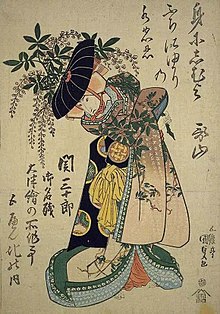| Fuji Musume藤娘 | |
|---|---|
 Seki Sanjuro II playing the Wisteria Maiden at the Nakamura-za, print by Utagawa Kunisada c. 1826 Seki Sanjuro II playing the Wisteria Maiden at the Nakamura-za, print by Utagawa Kunisada c. 1826 | |
| Written by | |
| Characters | Wisteria Maiden |
| Date premiered | 1826 |
| Place premiered | Nakamura-za, Edo |
| Original language | Japanese |
| Genre | shosagoto |
Fuji Musume (藤娘, The Wisteria Maiden) is a kabuki dance with lyrics written by Katsui Genpachi, choreography by Fujima Taisuke and music by Kineya Rokusaburô IV, first performed in 1826.
Originally part of a set of five different dances performed as a sequence, Fuji Musume is the only one that has survived. The first time these dances were staged in 1826 at the Nakamura-za in Edo, actor Seki Sanjuro II performed all of them as part of his farewell performance.
One of many revisions to the play, playwright Oka Onitaro [ja] and actor Onoe Kikugoro VI [ja] created a new, more supernatural version of the dance, staged for the first time in March 1937 at the Kabuki-za. In this version, the maiden becomes the spirit of the wisteria. The next year, performances of the dance by Onoe Baiko VII [ja] at the Minami-za in Kyoto and at the Kabuki-za in Tokyo, helped popularized the dance.
Fuji Musume remains a popular and famous dance in the kabuki repertoire.
Characters
The titular Wisteria Maiden is the only character seen in the play, and is accompanied by a nagauta musical ensemble of singers, shamisen, drums, flute and small gongs.
Plot
"Fuji Musume" is the visual climax of a Kabuki show, in which the dancer performing the role of the Wisteria Maiden changes kimonos four times and dances against a gorgeous backdrop of clusters of mauve and purple wisteria flowers. There is no story to speak of; the pleasure of the dance comes from the fast changes of costume which are performed on stage behind the trunk of a tree and the charming and winsome glances of the maiden as she expresses sentiments of love.
Translation
The play was translated into English by Leonard C. Pronko in Kabuki Plays on Stage III: Darkness and Desire, 1804-1864, edited by James R. Brandon and Samuel L. Leiter and published in 2002.
- Kabuki Plays on Stage III: Kabuki Plays on Stage III: Darkness and Desire, 1804-1864. (2002) University of Hawaii Press, ISBN 978-0824824556.
External links
References
- ^ "FUJI MUSUME". kabuki21. Retrieved 2018-01-08.
- ^ Kabuki Plays on Stage III: Kabuki Plays on Stage III: Darkness and Desire, 1804-1864. (2002) p. 166-169.
- "ONOE BAIKÔ VII". kabuki21. Retrieved 2018-01-08.
- ""Fuji Musumè" ( 藤娘 ) or "Wisteria Maiden" shown in flight". Zen Garden. Retrieved 2018-01-08.
- ""Fuji Musumè" ( 藤娘 ) or "Wisteria Maiden" shown in flight". Zen Garden. Retrieved 2018-01-08.